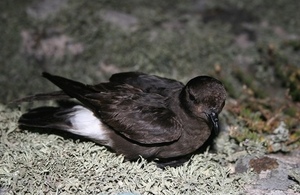Rare seabird makes a comeback in West Country
Thanks to two seabird conservation projects, the rare storm petrel has this year made a comeback in the West Country, breeding at new locations on the Isles of Scilly and for a second year on Lundy.

Storm petrel © Vic Froome
Storm petrels are tiny seabirds, about the size of a sparrow, that spend most of their lives at sea. They nest in burrows and are extremely rare breeding birds in England – confined entirely to the West Country. Up until last year the only place they nested was on a few outer rocks and islands in the Isles of Scilly. This year though, following the removal of rats that prey on chicks, the birds have been found nesting successfully on the inhabited islands of St Agnes and Gugh. They have also nested successfully on Lundy for a second year, where rats were removed 10 years ago.
The removal of rats from both St Agnes and Gugh on the Isles of Scilly, and from Lundy, is the result of a successful partnership between a wide range of conservation organisations and is part of a global effort to restore island seabird populations. As well as storm petrel, the work has benefitted Manx shearwater, guillemot and puffin. On Lundy puffin numbers have increased from 13 in 2000 to 80 in 2013, and shearwaters from 328 occupied burrows to 3,451 in the same period. On the Isles of Scilly last year, Manx shearwater bred successfully on St Agnes and Gugh for the first time in living memory.
Natural England’s Chairman, Andrew Sells, visited Lundy this week to find out about the island’s natural wonders, from its seabirds to its seals to its corals. He was on hand to witness Manx shearwaters being ringed. This visit followed earlier trips Andrew Sells has taken this summer to see conservation work being carried out on the Isles of Scilly and the Farne Islands.
Announcing the success of the storm petrels, he said: “It’s been tremendous to see how the partnership around Lundy has helped to conserve and enhance this beautiful island – not just the birds, but the things we can’t normally see, such as sunset cup corals and spiny lobsters.
“I’m thrilled to see such a massive leap in the Manx shearwater population and the news that storm petrels are breeding here now is just the icing on the cake.”
On the Isles of Scilly, Senior Seabird Ecologist Vickie Heaney said: “I have monitored St Agnes and Gugh for storm petrel nest sites for 15 years, and never had any response. They successfully nest on the nearby seabird island of Annet, which has no rats, but as their eggs and chicks would be predated on St Agnes and Gugh it appears they did not attempt to breed. After witnessing the prospecting behaviour of adult storm petrels over the years, we were thrilled to hear them calling back for the first time from six sites on St Agnes in July when they should be sitting on eggs. In order to prove successful breeding we returned to these sites in early September and were over the moon to hear the calls of hatched chicks from the within the nest sites.”
Jaclyn Pearson, Isles of Scilly Sea Bird Recovery Project Manager said; “Having confirmation of breeding storm petrels on St Agnes and Gugh within such a short space of time has exceeded all my hopes for this project. The team worked so hard finding evidence of storm petrels. Unlike larger Manx shearwaters which come out of their burrows at night to explore, so can be seen and recorded on trail cameras - tiny sparrow sized storm petrels are more elusive. I was absolutely delighted on the when we managed to get both sound recording and video footage of chicks. You can hear and watch the footage in the audio section of the project website www.ios-seabirds.org.uk. All the hard work that everyone has put into the project is all worth it when you know that a species has returned to habitat which is rightfully theirs.”
Sarah Mason, Chief Executive, Isles of Scilly Wildlife Trust said: “This is fantastic news for our seabirds; everyone involved with wildlife conservation on the Isles of Scilly is thrilled! The Isles of Scilly Wildlife Trusts work in managing more than 60% of the land is now more important than ever, as we must ensure that the breeding habitats for Storm petrels and other seabirds are in prime condition now and into the future.”
The Isles of Scilly Seabird Recovery Project is a partnership project between the RSPB, Isles of Scilly Wildlife Trust, Isles of Scilly Area of Outstanding Natural Beauty, Duchy of Cornwall and Natural England. The project is funded by LIFE, the EU’s programme for financing key environmental schemes across the continent, and a £269,100 grant from the Heritage Lottery Fund.
The Lundy Seabird Recovery Project was run by the Landmark Trust, National Trust, RSPB and Natural England.